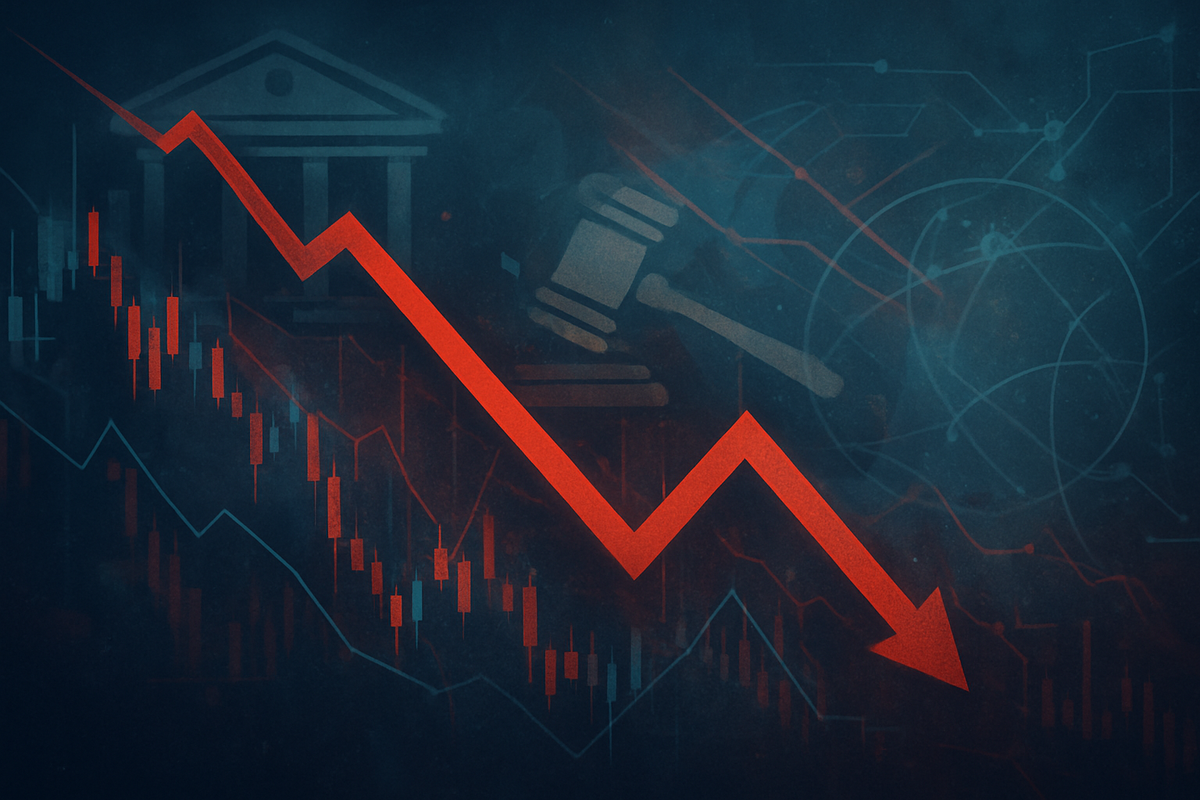
The global financial markets, as of October 30, 2025, are grappling with a complex interplay of factors, following a day characterized by stock futures pointing to a lower open and investor caution. This recent dip comes on the heels of major indexes hitting record highs, only to retract slightly after Federal Reserve Chair Jerome Powell hinted that further interest rate cuts might not be a certainty for December. Despite this immediate concern, a significant US-China trade truce, announced during the APEC Summit, has injected a guarded sense of optimism, offering a temporary reprieve from escalating trade tensions.
This article will delve into the nuanced market outlook, analyzing the immediate implications of recent declines, exploring potential future trends, and outlining crucial investor strategies. We will examine the forces shaping market trajectory, from central bank policies and geopolitical developments to sector-specific valuations and the sustainability of AI-driven growth, providing a comprehensive perspective on what investors should expect in the coming days and weeks.
Detailed Coverage of Recent Market Volatility
The recent market declines in October 2025 were a culmination of renewed U.S.-China trade tensions, a nuanced Federal Reserve interest rate decision, and persistent concerns over an "AI bubble" and economic slowdown. On October 10, 2025, U.S. stock indexes plunged after President Donald Trump threatened "massive" tariffs on China, specifically a 100% tariff on Chinese goods starting November 1. This announcement saw the Nasdaq Composite (NASDAQ: COMP) tumble 3.6%, the S&P 500 (NYSEARCA: SPY) sink 2.7%, and the Dow Jones Industrial Average (NYSEARCA: DIA) drop 1.9%, all recording significant weekly declines. This aggressive stance effectively reignited a trade war, sending shockwaves through global markets.
Leading up to this, September 2025 saw the U.S. Federal Reserve initiate a rate-cutting cycle, reducing its benchmark rate by 25 basis points. However, early October brought intensified warnings about a potential "AI bubble," with experts like Tom Essaye of Sevens Report Research suggesting a burst could lead to a 10% to 20% fall in the S&P 500. JPMorgan Chase (NYSE: JPM) CEO Jamie Dimon also voiced concerns about a serious market correction. On October 29, 2025, the Federal Open Market Committee (FOMC) cut rates by another 25 basis points, bringing the target range to 3.75-4.00%. Crucially, Fed Chair Jerome Powell indicated that a further rate cut in December was "not a foregone conclusion," tempering market expectations and contributing to the cautious sentiment observed on October 30.
Key players in this unfolding scenario include the U.S. government, particularly President Donald Trump, whose tariff policies were a direct catalyst for market jitters, and the U.S. Federal Reserve, led by Chairman Jerome Powell, whose monetary policy statements heavily influenced investor sentiment. China, under President Xi Jinping, is also a central figure in the ongoing trade negotiations. Financial institutions like JPMorgan Chase (NYSE: JPM) and market analysts from Sevens Report Research have been vocal about market risks. Corporations, especially technology giants such as Nvidia (NASDAQ: NVDA), Advanced Micro Devices (NASDAQ: AMD), Amazon (NASDAQ: AMZN), Meta Platforms Inc. (NASDAQ: META), Microsoft Corp. (NASDAQ: MSFT), and Alphabet (NASDAQ: GOOGL), are significant stakeholders, with their valuations and earnings heavily scrutinized.
Initial market reactions on October 30, 2025, were mixed but underscored a prevailing sense of caution. While the Dow Jones (NYSEARCA: DIA) slipped 0.2% and the S&P 500 (NYSEARCA: SPY) remained relatively flat, the Nasdaq Composite (NASDAQ: COMP) managed a 0.55% gain, largely buoyed by specific tech stocks. However, stock futures for major U.S. indexes pointed to a lower open, indicating underlying apprehension. Internationally, Indian and European markets traded lower, reflecting weak global sentiment. The 10-year Treasury yield rose to 4.10%, its highest in three weeks, signaling investor flight to safety and concerns about future inflation. Bitcoin (CRYPTO: BTC) and gold futures also saw declines. Trader sentiment, as per Charles Schwab's Q4 2025 survey, showed increased concerns about market overvaluation and potential volatility, with many diversifying into gold and crypto.
Companies Navigating a Treacherous Landscape
The current market environment, characterized by potential stock market declines, renewed trade tensions, and concerns about an "AI bubble," presents a bifurcated landscape for public companies. Certain sectors and businesses are poised to face significant headwinds, while others may demonstrate resilience or even find opportunities amidst the turbulence.
Companies heavily exposed to consumer discretionary spending are among the most vulnerable. Industries such as retail, hospitality, leisure, and travel will likely see reduced demand as consumer confidence wanes and spending tightens. Companies like Pool Corp. (NASDAQ: POOL), sensitive to economic downturns, could experience pressure despite their recurring revenue streams. The financial sector, including banks, investment firms, and insurance companies, may face rising loan defaults, decreased asset values, and tighter lending conditions. Manufacturing and industrial sectors could also suffer from declining global demand and disrupted supply chains. Furthermore, highly leveraged companies or those with substantial capital investments in their stock are at risk if their share prices fall significantly.
Renewed U.S.-China trade tensions, particularly with the threat of new tariffs, pose a direct threat to technology and export-oriented businesses. Semiconductor giants like Nvidia (NASDAQ: NVDA) and Advanced Micro Devices (NASDAQ: AMD) have already seen share price drops due to increased component costs, reduced demand in key markets like China, and disrupted manufacturing networks. The global semiconductor industry is undergoing fragmentation, pushing companies towards regional ecosystems, which can increase costs and complexity. Sectors such as automotive, electrical and machinery equipment, and textiles are also highly susceptible to tariffs, facing squeezed margins and lower sales. Companies reliant on China's rare earth elements, crucial for high-tech manufacturing, could face price spikes and global shortages if export controls are implemented.
Concerns about an "AI bubble" bursting add another layer of risk, primarily for AI-dependent tech companies with high, speculative valuations. Companies whose stock prices have surged primarily due to AI hype, particularly those with high asset growth but limited current profitability, are vulnerable to significant corrections. This includes firms rapidly increasing capital expenditures in AI infrastructure, as historical patterns suggest a risk of overinvestment and poor long-term returns. For example, Meta Platforms Inc. (NASDAQ: META) tumbled 11% on October 30, partly due to debt taken to fund its ambitious AI initiatives. A potential "extinction event" for less capitalized Generative AI model providers could occur, consolidating power among the stronger players but also highlighting the fragility of the sector.
Conversely, defensive sectors and companies offering essential services are likely to be more resilient during market downturns. Consumer staples companies, such as PepsiCo (NASDAQ: PEP), Clorox (NYSE: CLX), Procter & Gamble (NYSE: PG), and Kimberly-Clark (NYSE: KMB), are expected to maintain stable demand for their products. The healthcare sector, including pharmaceutical and medical device companies like Johnson & Johnson (NYSE: JNJ), typically remains robust due to consistent demand for medical care. Utilities, providing essential services like electricity and water, are considered recession-proof. Cybersecurity providers, such as CrowdStrike (NASDAQ: CRWD), are also seen as resilient, as data safety remains a critical business need regardless of economic conditions. Companies with strong balance sheets and low debt are better positioned to weather financial turbulence and capitalize on opportunities.
Trade tensions, while generally negative, could indirectly benefit domestic manufacturers and suppliers in protected industries, as tariffs on imports aim to boost local competitiveness. Companies actively diversifying their supply chains away from China to countries like Vietnam, India, and Malaysia may also gain long-term resilience. Furthermore, in the event of an AI bubble "soft landing," core AI infrastructure providers with sustainable business models, such as diversified tech giants like Microsoft Corp. (NASDAQ: MSFT), Alphabet (NASDAQ: GOOGL), and Amazon (NASDAQ: AMZN), which are strategically investing in AI, could continue to thrive. These companies have the financial resilience to weather a correction while continuing to innovate and integrate AI for efficiency gains across their vast ecosystems.
Overall, the current environment points towards increased volatility and a bifurcation of market performance. Companies providing essential services, having strong balance sheets, or strategically adapting to geopolitical and technological shifts are better positioned to navigate these challenges. Conversely, highly leveraged companies, those in cyclical industries, and those with speculative valuations in overhyped sectors face significant headwinds, potentially leading to decreased revenue, supply chain disruptions, and valuation adjustments.
The Wider Significance: A Confluence of Trends and Historical Echoes
Stock market declines, such as those observed in October 2025, extend far beyond immediate portfolio impacts, triggering widespread ripple effects across various industries and prompting significant regulatory and policy considerations. These events also resonate with historical precedents, offering valuable lessons for market participants and policymakers alike.
One of the broader industry trends highlighted by recent volatility is the divergent performance across sectors. Vulnerable sectors, including financial services, consumer discretionary, manufacturing, and real estate, typically bear the brunt of downturns. Banks face rising default rates, while consumer-facing industries experience reduced demand. Conversely, resilient sectors like healthcare, consumer staples, and discount retail often demonstrate stability or even growth, as they provide essential goods and services. A notable trend in late 2025 is the increasing concentration of market capitalization in a few mega-cap technology companies, particularly those driving AI innovation. This consolidation of market power can widen the gap between tech-forward and traditional industries, though signs of fatigue in AI sentiment are beginning to emerge, with rising yields and rotation pressures.
The ripple effects of market declines are extensive, impacting competitors and partners throughout the business ecosystem. Reduced consumer spending and investment, driven by eroded wealth and confidence, directly affect businesses, potentially leading to lower revenues, job losses, and closures. Tightening credit conditions, as banks become more cautious, further stifle economic activity, particularly for industries reliant on borrowing. Supply chain disruptions are exacerbated by geopolitical tensions and trade wars, such as the worldwide tariffs imposed in April 2025, forcing companies to build more resilient and diversified supply chains. Increased competition for shrinking demand and accelerated merger and acquisition (M&A) activity, especially in the tech sector, are also common outcomes. Furthermore, volatile currency fluctuations, as investors seek safe havens, can significantly impact international trade and investment.
Regulatory and policy implications are a crucial aspect of market downturns. Central banks, like the Federal Reserve, typically respond with monetary policy adjustments, such as interest rate cuts, to inject liquidity and stimulate borrowing and spending. As of late 2025, discussions around further Fed rate cuts are ongoing, despite Chairman Powell's recent cautious remarks. Governments may also implement fiscal stimulus packages or bailouts to stabilize struggling industries. Market crashes often expose systemic vulnerabilities, leading to new or revised financial system regulations aimed at increasing transparency and investor protection. For instance, India's market regulator proposed significant overhauls to mutual fund regulations in October 2025, aiming for greater transparency, which subsequently impacted asset management companies. The ethical implications of AI's rapid integration, particularly concerning academic integrity and data privacy, are also prompting closer regulatory scrutiny.
Historically, market declines are an inherent part of investing, with various events serving as precedents. The Great Crash of 1929, the Dot-Com Bubble Burst in the early 2000s, and the 2008 Financial Crisis all offer lessons on the causes and consequences of significant market corrections. More recently, the COVID-19 recession in 2020 and the 2024 China stock market crash underscore the diverse triggers of market volatility. Notably, the "Liberation Day" crash on April 2, 2025, attributed to worldwide tariffs imposed by U.S. President Donald Trump, marked the largest U.S. market decline since the COVID-19 pandemic. While each event has unique characteristics, a consistent theme is that markets have historically recovered, often with strong rebounds. The key takeaway from these historical events is the importance of financial stability, cautious central bank responses, and the resilience of the economy to adapt to shocks, even as investors are advised against panic selling.
What Comes Next: Navigating a Period of Uncertainty and Opportunity
The aftermath of recent market declines on October 30, 2025, sets the stage for a period defined by both short-term volatility and evolving long-term trends. Investors and businesses alike must prepare for a dynamic landscape shaped by monetary policy, geopolitical developments, and technological advancements.
In the short term (late 2025 - early 2026), continued market volatility is highly probable, influenced by ongoing central bank decisions, economic data releases, and corporate earnings. While some analysts foresee a potential technical recession in 2026, certain defensive sectors like utilities, healthcare, and consumer staples are expected to offer relative stability. The Federal Reserve's cautious stance on further rate cuts, despite previous reductions, will keep inflation and interest rate concerns at the forefront, potentially dampening expectations for accelerated easing. Commodity prices are broadly projected to decline, contributing to global disinflation, although precious metals are forecast to rise, indicating a flight to safety.
Looking further ahead, the long-term market possibilities are shaped by moderating global growth, with the U.S. real GDP growth expected to slow into 2026. Elevated long-term interest rates, potentially remaining above 4.1% through 2030, will continue to influence capital markets. Demographic shifts and the ongoing trend of "de-dollarization" are also anticipated to have a lasting impact. Crucially, digital transformation and AI integration are expected to remain powerful drivers of business investment and productivity, even amidst economic headwinds. However, warnings from experts about the increased probability of a serious market correction in the next six months to two years, potentially driven by high valuations of AI companies, underscore the need for vigilance.
Strategic pivots and adaptations are paramount for both businesses and investors. Businesses must prioritize agility, fortify balance sheets with substantial cash reserves, and focus on profitability over aggressive revenue growth. Leveraging AI for productivity and cost efficiencies, alongside reconfiguring supply chains for greater resilience against geopolitical shifts and tariffs, will be critical. Scenario planning to prepare for a range of plausible futures is also essential. For investors, diversification across asset classes, sectors, and regions remains key. A long-term perspective, avoiding panic selling, and employing dollar-cost averaging are consistently advised. Seeking safe-haven assets like U.S. Treasury securities, gold, and dividend-paying stocks in defensive sectors can provide protection during turmoil. Market downturns also present strategic opportunities to acquire high-quality stocks at discounted prices for those prepared to act.
Potential scenarios range from a short-term correction followed by long-term growth, where the market finds a bottom and gradually recovers, driven by resilient earnings and AI innovation. Another scenario involves extended volatility and slow growth, possibly reflecting stagflationary concerns, leading to prolonged sideways movement as businesses grapple with higher costs and reduced consumer spending. The most challenging scenario is a deeper bear market or recession, triggered by aggressive monetary tightening or unforeseen shocks, resulting in significant portfolio declines and severe challenges for companies. The market's future trajectory after October 30, 2025, is a complex interplay of economic indicators, central bank policies, geopolitical events, and the adaptive capacity of businesses and investors.
Comprehensive Wrap-up: Navigating the New Normal
The recent market declines in October 2025 have underscored the inherent unpredictability of financial markets, characterized by a complex interplay of central bank actions, geopolitical tensions, and evolving economic fundamentals. A key takeaway is the Federal Reserve's cautious stance, with Chairman Jerome Powell indicating a potential pause in further rate cuts despite previous reductions. This, coupled with mixed corporate earnings and persistent US-China trade uncertainty, fueled volatility across asset classes, including a dramatic surge and stabilization in gold prices. Despite these immediate challenges, the S&P 500 (NYSEARCA: SPY) has shown resilience, recovering from earlier dips and with corporate America on track for a ninth consecutive quarter of earnings growth.
Moving forward, the market's trajectory will be heavily influenced by central bank policies and inflation dynamics. The Fed's observational stance, against a backdrop of elevated consumer inflation and acknowledged economic uncertainty, suggests a cautious approach to monetary policy. Economists anticipate core inflation to remain above 2.5% for most of 2025, with U.S. real GDP growth cooling. While most traders expect inflation to stabilize, concerns about stagflation are growing. Despite these headwinds, the equity outlook remains cautiously positive, with J.P. Morgan Research projecting the S&P 500 (NYSEARCA: SPY) to close near 6,000 by year-end, driven by double-digit earnings growth. The bond market also expects stable returns, and international markets, particularly the eurozone, show signs of potential growth into 2026.
The lasting impact of this period is the undeniable shift towards a "Tech+" economy, where artificial intelligence and automation fundamentally reshape growth, with tech firms now comprising nearly half of the S&P 500's (NYSEARCA: SPY) market capitalization. Corporate America has demonstrated remarkable adaptability to uncertainty, diversifying supply chains, near-shoring operations, and investing in technology to manage costs. The period also highlights the enduring value of diversification, with international indices showing stronger performance after a decade of U.S. outperformance, and the U.S. dollar now considered overvalued. The sustained buying of gold by central banks signals a permanent demand and price floor for the precious metal, reinforcing its role as a store of value.
In the coming months, investors should remain vigilant and closely monitor central bank communications, particularly from the Federal Reserve, regarding interest rate policies and economic data such as inflation, employment reports, and consumer confidence. Corporate earnings and outlooks will be crucial for assessing business health and broader economic conditions. Geopolitical developments, especially the evolving US-China trade relationship, will continue to impact global markets. Investors should also review their portfolios for adequate diversification across asset classes and consider year-end financial planning strategies, including maximizing contributions to tax-advantaged accounts and exploring tax-loss harvesting. This proactive approach will be essential for navigating the complex and evolving market landscape.
This content is intended for informational purposes only and is not financial advice





